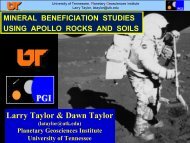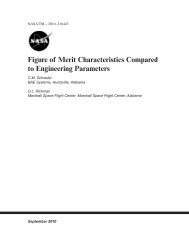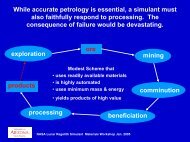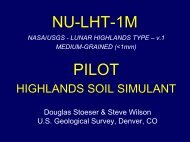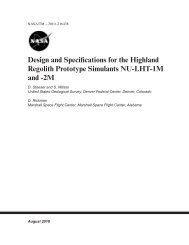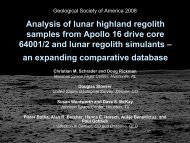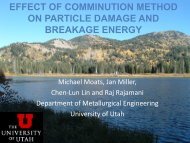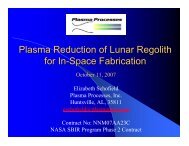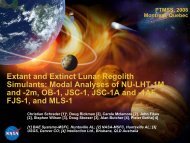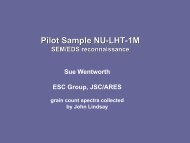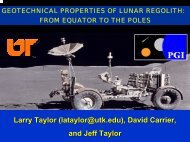Book of Abstracts- Lunar Regolith Simulant Materials Workshop
Book of Abstracts- Lunar Regolith Simulant Materials Workshop
Book of Abstracts- Lunar Regolith Simulant Materials Workshop
Create successful ePaper yourself
Turn your PDF publications into a flip-book with our unique Google optimized e-Paper software.
to exist on the moon. Figure 3 shows complete size<br />
distribution histograms for a number <strong>of</strong> soils and for<br />
several kinds <strong>of</strong> reference material.<br />
Immature Soils. Immature soils (e. g. 71061) are<br />
<strong>of</strong>ten bimodal and mature soils are usually single modal<br />
with narrower standard deviation. The volcanic<br />
soil 74220 is more fine grained and has the lowest<br />
standard deviation <strong>of</strong> any measured lunar soil. Yet it<br />
has no agglutinates. This radical disconnect between<br />
maturity-related properties means it was clearly produced<br />
by a radically different process compared to<br />
typical soils. Also note that lunar soils do not match<br />
the size distribution <strong>of</strong> either single impact communition<br />
or <strong>of</strong> calculated multiple impact communition.<br />
The essential difference is mainly the result <strong>of</strong> the role<br />
<strong>of</strong> constructional particles.<br />
Figure 4 illustrates the end-member path that soils<br />
take on the moon with repeated bombardment.<br />
One result <strong>of</strong> this mixing is that different grain size<br />
fractions may consist <strong>of</strong> subsets <strong>of</strong> differing maturity;<br />
these subsets or fractions <strong>of</strong> the complete soil may then<br />
have their own fractional maturity. Figure 6 shows the<br />
resultant <strong>of</strong> the mixing <strong>of</strong> two soils <strong>of</strong> differing maturity.<br />
The fine-grained part is dominated by one soil and<br />
the coarse-grained part is dominated by the other soil.<br />
If the parent soils are different initial compositions, the<br />
chemical and mineral composition <strong>of</strong> the resulting size<br />
fractions may differ radically from coarse to fine.<br />
Because communition and agglutination may occur<br />
at differing rates, a typical soil may reach equilibrium<br />
between the two processes (Fig. 7).<br />
Mixing <strong>of</strong> Soils. Large blocks produced from bedrock<br />
are ground down and become more mature. The<br />
final result is a balance between destructional particles<br />
and constructional particles. In this path, essentially all<br />
components have the same maturity. The other end<br />
member (Figure 5), represented by many soils, includes<br />
significant mixing <strong>of</strong> soils <strong>of</strong> differing maturities.<br />
However, if the supply <strong>of</strong> coarse particles is greater<br />
for one soil, its equilibrium point may be different<br />
from another soil. Hence, this equilibrium is really a<br />
dynamic steady state set by the supply <strong>of</strong> coarse<br />
6



